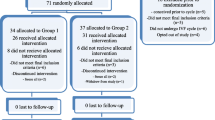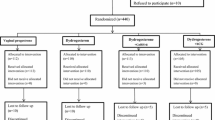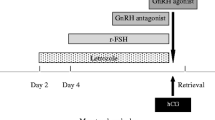Abstract
Objective
The purpose of the study was to determine the impact of two forms of luteal-phase supplementation, human chorionic gonadotropin (hCG) and progesterone (P), during gonadotropin releasing hormone agonist (GnRha)/controlled ovarian hyperstimulation (COH) cycles.
Design and Patients
The study was a prospective, randomized evaluation of 77 patients. Group 1 patients (n=38) received 2000 IU of hCG, injected subcutaneously, on days 3, 6, 9, and 12 after transvaginal aspiration of the oocytes (TVA=day 0). Group 2 patients (n=39) received 50-mg daily injections of intramuscular (i.m.) P from days 2 to 14 after TVA. Blood tests were performed on days 0, 5, 8, and 12 after TVA.
Setting
The in vitro fertilization program of a tertiary care institution was the study setting.
Main Outcome Measures
The main outcome measures were (1) pregnancy and implantation rates; (2) serum estradiol (E), P, and hCG levels; and (3) occurrence of side effects.
Results
Clinical pregnancy and implantation rates in group 1 versus group 2 were similar (36.7 vs 35.3 and 12 vs 14%, respectively). Regardless of pregnancy occurrence, on days 8 and 12 after TVA, serum E and P levels were higher in group 1 than group 2 but the resulting E/P ratios were similar. Five of 38 patients (group 1) developed moderate to severe ovarian hyperstimulation syndrome (OHSS) right after the first or second supplementary hCG injection. In these patients, the mean serum E level on the day of hCG trigger injection was about 3250 pg/ml and the number of follicles was between 9 and 17. In 6 of 39 patients (group 2) allergic reactions were observed at the P injection sites.
Conclusions
Based on our data, hCG administration as a form of luteal supplementation did not translate, in comparison to P, into significant benefits for the patients. At the same time, it significantly increased the risk of ovarian hyperstimulation. We suggest that whenever, during COH cycles, serum E levels are over 2500 pg/ml and the number of follicles exceeds 10, luteal support with hCG should be excluded.
Similar content being viewed by others
References
Daya S: Efficacy of progesterone support in the luteal phase following in vitro fertilization and embryo transfer. Hum Reprod 1988;3:731–734
Kupferminc MJ, Lessing JB, Amit A, Yovel I, David MP, Peyser MR: A prospective randomized trial of human chorionic gonadotrophin or dydrogesterone support following in-vitro fertilization and embryo transfer. Hum Reprod 1990;5:271–273
Smitz J, Devroey P, Braeckmans P, Camus M, Khan I, Staessen C, Van Waesberghe L, Wisanto A, Van Steirtghem AC: Management of failed cycles in an IVF/GIFT programme with the combination of a GnRh analogue and HMG. Hum Reprod 1987;2:309–314
Smitz J, Devroey P, Camus M, Van Waesberghe L, Wisanto A, Van Steirteghem AC: The luteal phase and early pregnancy after combined GnRh-agonist/HMG treatment for superovulation in IVF and GIFT. Hum Reprod 1988;3:585–580
Herman A, Ron-El R, Golan A, Raziel A, Soffler Y, Caspi E: Pregnancy rate and ovarian hyperstimulation after luteal human chorionic gonadotrophin in in-vitro fertilization stimulated with gonadotrophin-releasing hormone analog and menotrophins. Fertil Steril 1990;53:92–96
McClure N, Leya J, Radwanska E, Rawlins R, Haning RV Jr: Luteal phase support and severe ovarian hyperstimulation syndrome. Hum Reprod 1992;7:758–764
de Los Santos MJ, Tarin JJ, Gomez E, Remohi J, Pellicer A: Daily measurements and in-vitro effects of human chorionic gonadotrophin in the early luteal phase. Hum Reprod 1993;8:2047–2051
Ben-Nun I, Jaffe R, Fejgin MD, Beyth Y: Therapeutic maturation of endometrium in in-vitro fertilization and embryo transfer. Fertil Steril 1992;57:953–962
Buvat J, Marcolin G, Louvet A, Herbaut JC: Luteal support after GnRh analog for IVF: superiority of hCG over oral progesterone. Fertil Steril 1990;53:92
Smitz J, Devroey P, Faguer B, Bourgain C, Camus M, Van Steirteghem AC: A prospective randomized comparison of intramuscular or intravaginal natural progesterone as a luteal phase and early pregnancy supplement. Hum Reprod 1992;7:168–175
Mordel N, Schenker JG: Gonadotrophin-releasing hormone agonist and ovarian hyperstimulation syndrome in assisted reproduction. Hum Reprod 1993;8:2009–2014
Smith EM, Anthony FW, Gadd SC, Masson GM: Trial of support treatment with human chorionic gonadotrophin in the luteal phase after treatment with buserelin and human menopausal gonadotrophin in women taking part in a in vitro fertilization programme. Br Med J 1989;298:1483–1486
Belaisch-Allart J, De Mouzon J, Lapouterle C, Mayer M: The effect of hCG supplementation after combined GnRh agonist/HMG treatment in an IVF programme. Hum Reprod 1990;5:163–166
Gerli S, Remohi J, Patrizio P, Borrero C, Balmaceda JP, Silber SJ, Asch RH: Programming of ovarian stimulation with norethindrone acetate in IVF/GIFT cycles. Hum Reprod 1989;4:746–748
Asch RH, Li H-P, Balmaceda JP, Weckstein LN, Stone S: Severe ovarian hyperstimulation syndrome in assisted reproductive technology: Definition of high risk groups. Hum Reprod 1991;6:1395–1399
Balmaceda JP, Borrero C, Gastaldi C, Ord T, Remohi J, Asch RH: Tubal embryo transfer as a treatment for infertility due to male factor. Fertil Steril 1988;50:476–479
Schenker JG, Weinstein D: Ovarian hyperstimulation syndrome: A current survey. Fertil Steril 1978;30:255–268
Balasch J, Jove I, Marquex M, Varuell JA: Hormonal and histological evaluation of the luteal phase after combined GnRh-agonist/gonadotrophin treatment for superovulation and luteal phase support for in-vitro fertilization. Hum Reprod 1991;6:914–917
van Steirteghem AC, Smitz J, Camus M, Wisanto A, Devroey P: The luteal phase after in vitro fertilization and related procedures. Hum Reprod 1988;3:161–164
Smitz J, Bourgain C, Van Waesberghe L, Camus M, Devroey P, Van Steirtghem AC: A prospective randomized study on oestradiol valerate supplementation in addition to intravaginal micronized progesterone in buserelin and HMG induced superovulation. Hum Reprod 1993;8:40–45
Claman P, Domingo M, Leader A: Luteal phase support in in-vitro fertilization using gonadotrophin releasing hormone analogue before ovarian stimulation: A prospective randomized study of human chorionic gonadotrophin versus intramuscular progesterone. Hum Reprod 1992;7:487–489
Perrot-Applanat M, Deng Mei, Fernandez H, Lelaider C, Meduri G, Bouchard P: Immunohistochemical localization of estradiol and progesterone receptors in human uterus throughout pregnancy: Expression in endometrial blood vessels. J Clin Endocrinol Metab 1994;78:216–224
Rizk B, Smitz J: Ovarian hyperstimulation syndrome after superovulation using GnRh agonists for IVF and related procedures. Hum Reprod 1992;7:320–327
Chegini N, Lei ZM, Rao ChV, Hansel W. Cellular distribution and cycle phase dependency of gonagotropin and eicosanoid binding sites in bovine corpora lutea. Bio Reprod. 1991;45:506–13.
Jimenez AE, Miller JB, Passmore JC, Rao ChV: Effect of human chorionic gonadotropin on blood flow to rat reproductive organs. Abstract no. P223. 41st Annual Meeting of the Society for Gynecologic Investigation, March 1994. Chicago.
Navot D, Bergh PA, Laufer N: Ovarian hyperstimulation syndrome in novel reproductive technologies: Prevention and treatment. Fertil Steril 1992;58:249–261
Author information
Authors and Affiliations
Rights and permissions
About this article
Cite this article
Araujo, E., Bernardini, L., Frederick, J.L. et al. Prospective randomized comparison of human chorionic gonadotropin versus intramuscular progesterone for luteal-phase support in assisted reproduction. J Assist Reprod Genet 11, 74–78 (1994). https://doi.org/10.1007/BF02215991
Received:
Accepted:
Issue Date:
DOI: https://doi.org/10.1007/BF02215991




